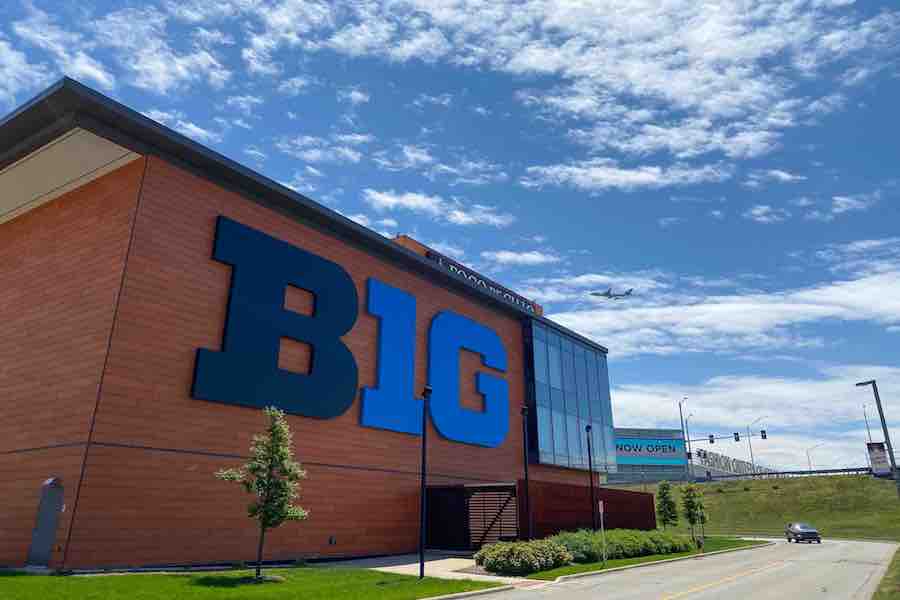Rosenberg: The Big Ten’s decision on football raises more questions than it answers
Daily file photo by Joshua Hoffman
The Big Ten headquarters in Rosemont. The conference will begin a nine-game football season in late October.
September 20, 2020
Football
Kevin Warren’s open letter on August 19 seemed like a final decision. The Big Ten commissioner backed up the conference’s move to postpone football and other fall sports eight days prior with powerful language, saying the decision “will not be revisited.”
Less than a month later, the vote was revisited — and reversed.
For the most part, Warren has been a good leader for the Big Ten. But going back and reversing a smart decision proved just how big a motivator money can be.
Warren made himself quite clear in the August 19 letter, clarifying that the vote of the Big Ten Council of Presidents and Chancellors (COP/C) was “overwhelmingly in favor of postponing fall sports.” The letter listed several factors that influenced their decision, including rising COVID-19 cases, too much unknown information and concerns about contact tracing.
Those concerns haven’t gone anywhere since then. Yes, the Big Ten and the athletic departments of its 14 schools would have sustained huge revenue losses without football. But Wednesday’s unanimous vote to start the season in late October provided few answers — and prompted plenty of questions.
All players, coaches and training staff will be tested daily, reducing the need for contact tracing, and the conference has strict cutoffs in place for teams based on rates of positive cases. But that testing could dip into the supply for the non-athletes on Big Ten campuses.
When Daily reporter Peter Warren asked NU athletic director Jim Phillips about this at a press conference last Wednesday, shortly after the decision was released, Phillips dodged the question. In essence, he said the presidents and chancellors made the decision without much reflection on the consequences for the campus and Evanston communities, who may need the tests more.
Another issue: the schedule does not allow for any makeup games. Each team will play eight regular-season games in as many weeks, from Oct. 24 through Dec. 12, followed by what the conference is calling “Champions Week” on Dec. 19. The division winners will meet in the conference championship game, as usual, and everyone else will play an additional crossover opponent based on the standings.
This leaves no insurance policy in the event a game is canceled because of COVID-19. What happens then? And what happens to the standings if teams have played unequal numbers of games? The Big Ten has not provided any information about this, and is likely just holding out hope that this scenario will not come to pass.
The conference is also yet to make an announcement about other fall sports. While the Wildcats’ football team can finally practice knowing they have games to prepare for, NU’s men’s and women’s soccer, volleyball, field hockey and cross country teams are still waiting. It’s not fair for them to be practicing without any idea whether they’re preparing for anything meaningful.
The NCAA announced that fall championship tournaments will be moved to the spring, with 75 percent of the normal number of teams participating, but neither Northwestern nor the Big Ten have said whether they will act accordingly and hold their seasons between January and April.
Even if NU’s other fall teams do play in the winter and spring, field space with overlapping seasons becomes an issue — volleyball shares Welsh-Ryan Arena with basketball and wrestling, while soccer shares Martin Stadium with lacrosse.
I’m not saying unequivocally that the Big Ten should not be playing football. If the players are willing and administrators think it can be done safely, then maybe it’s worth a try. But the conference has left itself with hardly any margin for error, and it has a lot to answer in the next month before anyone takes the field.
Email: benjaminrosenberg2021@u.northwestern.edu
Twitter: @bxrosenberg
Related Stories:
— Football: What to know about the Big Ten’s October return
— Football: Big Ten unveils updated 2020 schedule
— Football: Big Ten reverses decision, votes to return to play in late October



